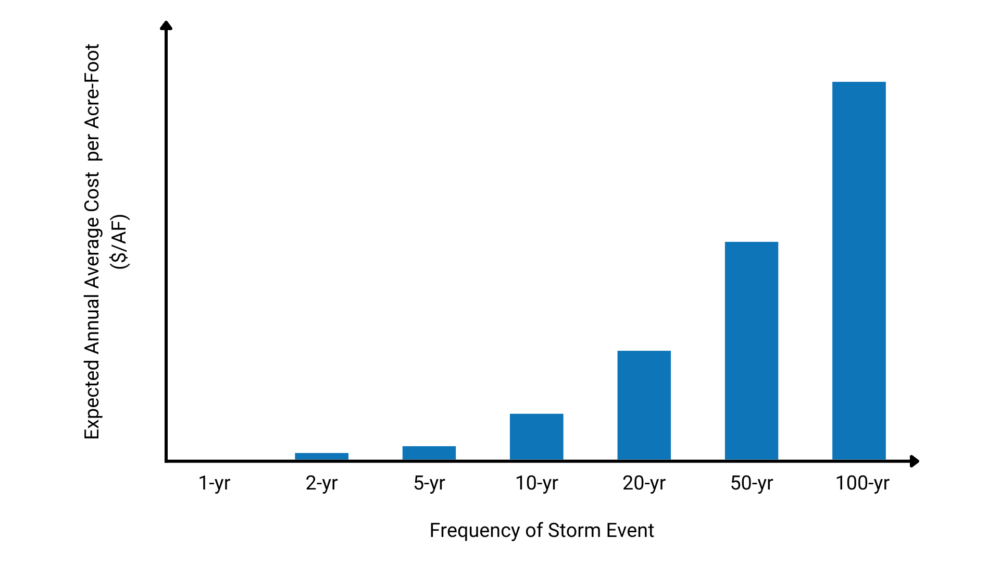By Roger Mann and Stephen Hatchett, Senior Principal Economists
Many persons have recently commented on water flowing through yards, streets, drains, and channels on to the ocean. They ask, rightfully, why we don’t catch and store more urban stormwater runoff for use as water supply? Additional imported water supplies from the Delta and Colorado River are unreliable and costly even if available. Desalination and wastewater recycling are usually even more expensive.
In many cases, capturing and recharging urban stormwater runoff to groundwater makes sense and is cost-effective. The State has provided substantial funding through Proposition 1, IRWM programs, and the SGM Program for stormwater capture and groundwater recharge. Local agencies are also investing in such opportunities. The City of LA just recently announced an expanded stormwater program and other urban agencies are also pursuing more ambitious plans.
Stormwater capture and storage for water supply is cost-effective for many urban situations. However, it can be expensive to build the facilities required to capture and utilize the large volume of water generated by large storms. First, cost of capacity to capture and recharge additional stormwater rises steeply as the size of a storm increases. Second, the less frequent the storm, the more expensive it is per acre-foot (AF) per year of water saved. Cost per year increases simply because the frequency of use of the recharge capacity declines with larger, less frequent storms.
Land is needed for conveyance, retention (temporary storage), and recharge basins. Urban land is not cheap. As larger, less frequent flows are targeted, the cost of acquiring and managing additional land can become prohibitive. Land may be required to retain stormwater in advance of recharge. During and after large events, any land suitable for recharge may be already flooded and recharging at its capacity. Reconfiguring large urban parks, abandoned quarries, or other vacant land may be used to enable more retention and recharge. Injection wells may be required to overcome natural recharge limitations.
An example cost curve below shows the cost per annual average AF captured and recharged for increasingly large events. The curve begins to rise steeply as larger facilities are required to capture larger but less frequent storms. A 20-year storm or larger has a 5 percent chance of occurring in a given year, a 100-year storm or larger has a 1 percent chance, and so on. Runoff generated from normal storms and storms that occur every few years can be quite cheap to capture and recharge. But the annual average cost starts to rise rapidly for large and infrequent storm events. In most locales, inexpensive options for stormwater capture have already been built.

Urban stormwater runoff projects can be designed to do more than store and recharge water. Multi-purpose projects consider a variety of additional benefits associated with stormwater capture. The project may provide flood damage reduction benefits by reducing downstream flow. Multi-purpose recharge projects with habitat restoration may provide wildlife habitat benefits. Urban stormwater is often degraded by biological wastes and chemicals. Stormwater projects can be, and often are, designed to capture degraded flows for treatment before the water enters local waterways or the near ocean environment.
Recharge economics can be very different in agricultural areas. Land is less expensive and existing infrastructure can be complementary. Groundwater sustainability agencies (GSAs) across the state are investing state and local dollars in programs to divert surplus flows onto farms or into dedicated recharge basins. Our team is supporting some GSAs with these important projects that help keep farmland in production and protect jobs for local communities. The Flood-Managed Aquifer Recharge (MAR) method concept uses existing diversion and conveyance facilities in agricultural areas to spread water onto fields for recharge during winter. Challenges are that existing diversions cannot capture larger flood flows, percolation is often slower than in designed recharge basins, agricultural chemicals may be mobilized into the groundwater, and recharge on farmlands imposes costs and risks to the farming operation. In inland regions, some floodwater recharge may not be feasible or economical because of downstream water rights, or the water has other important benefits downstream such as providing flushing flow for estuaries. Finally, our understanding of the frequency and intensity of storms is changing as we gain better understanding of climate and weather pattern shifts. Deeper, longer droughts coupled with more intense storm events could change the expected net benefits from local recharge projects. Our team continues to develop data and methods to value benefits in support economic and financial evaluations of projects to capture stormwater and other surplus flows.
If you’re interested to talk more about capture of stormwater runoff, please contact Roger Mann or Stephen Hatchett.



